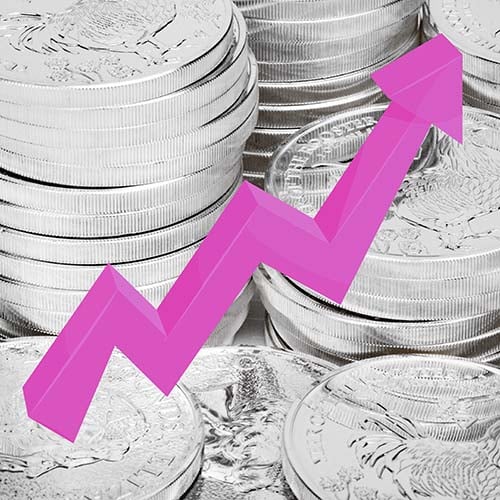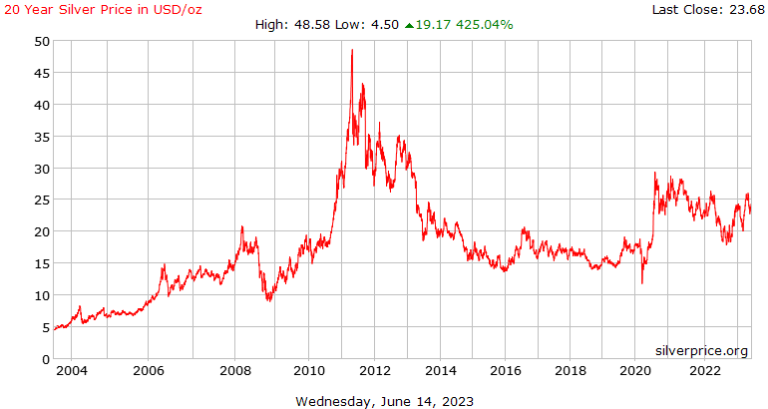Historical Silver Price Per Gram

Silver has been a valuable commodity since antiquity, with its worth being determined by a variety of factors including supply, demand, and market forces. Through analyzing historical silver prices per gram, we can gain insight into how the value of silver has changed over time.
From pre-20th century to the 21st century, this article will explore the significant changes in price as well as investigate the underlying influences that have affected those changes. Furthermore, an assessment of current silver prices in comparison to historic pricing will be provided to offer readers a comprehensive understanding of this precious metal’s evolution.
Pre-20th Century Silver Prices
Pre-20th century silver prices provide a fascinating glimpse into the past. During this period, understanding of the precious metal’s value was largely determined by regional and international trade patterns.
In Europe, for example, silver was often traded in exchange for other goods such as spices from India or textiles from China. Depending on the region, silver may have been valued more highly than gold due to its relative rarity and tendency to retain its value over time.
In some parts of Europe, coins made from silver were also used as currency during this period. Different countries minted their own coins with specific weights and purity levels that dictated their worth when exchanged. This allowed merchants to essentially create an economy based on trading these coins, which in turn affected the overall price of silver per gram in each country or region.
As with any commodity in a free market system, understanding how much it is worth is largely dependent on supply and demand dynamics at any given moment in time.
20th Century Silver Prices
The 20th century saw a dramatic rise in the value of silver as a precious metal, making it an increasingly desirable commodity. This trend was especially noticeable in industrialized countries where the demand for silver increased significantly due to its use in many industrial processes.
As a result, the price of silver per gram began to climb steadily throughout the 20th century and continued into the 21st century. The exact prices varied from year to year depending on factors such as supply and demand, but generally speaking, silver prices rose at a steady rate during this period. Additionally, fluctuations were observed between different world markets due to differences in economic conditions among nations.
Despite these variations, it is clear that over time, silver prices have been on a steady upward trend since the beginning of the 20th century.
21st Century Silver Prices
In the 21st century, the value of silver as a precious metal has continued to rise at a steady rate, with prices increasing significantly over the past two decades.
For example, in 2020, silver prices reached their highest level since 1980.
The surge in demand for silver was due to increased investment activity from both institutional and retail investors who were attracted by its low-risk properties and long-term appreciation potential.
As a result, average annual prices for silver rose from around $4 per ounce in 2000 to nearly $17 per ounce in 2021.
The increase in demand also had an effect on the spot price of silver, which is determined by supply and demand dynamics in the market.
Over time, this led to an increase of about 200% from around $5 per gram to more than $15 per gram between 2000 and 2021.
In addition, with greater investor interest came increased speculation about future price movements that further drove up silver prices during this period.
Factors Influencing Silver Prices
Long-term investments in silver can be heavily influenced by a variety of economic and political factors. These include:
- Economic growth and recession cycles, which can affect the value of silver;
- Central bank policies, such as quantitative easing or the introduction of new currency, both of which could influence the price of silver;
- Political events and international relations, such as trade wars or sanctions, which could impact the demand for silver bullion.
The supply and demand for silver is also an important factor in determining its price. The availability of newly mined silver will determine how much is available on the market to purchase, while increases in industrial demand could cause a spike in prices due to increased competition among buyers.
Additionally, investors often shift funds from other commodities into precious metals like silver when they perceive risk elsewhere in markets. This phenomenon has been seen with increasing frequency during times of economic uncertainty or market volatility over recent years.
Comparison of Silver Prices Today and Historically
Comparing the current cost of silver to its past valuations provides an interesting insight into how economic and political factors can shape the market. Silver prices have fluctuated significantly over time, depending on a wide variety of influencing factors.
In general, it can be seen that technological advancement, industrial demand, and geopolitical events have had the greatest impact on silver prices. For example, in the mid-1800s when photography was invented, demand for silver surged as it was used to develop photos. Additionally, during World War II there were significant increases in the price of silver due to increased industrial production and an increase in demand from investors looking for safe havens for their money. Similarly, more recently geopolitical events such as Brexit have caused fluctuations in silver prices since 2017.
Despite these movements within short-term periods of time, overall trends reveal that historically silver has maintained its relative value compared with other commodities like gold and copper. This is largely due to the fact that while supply can be affected by external forces such as mining disruption or government intervention in pricing policies, demand remains relatively stable given its wide range of uses across different industries from jewelry making to electronics manufacturing.
As a result of this stability of both supply and demand for silver over longer periods of time, comparisons between today’s prices and historical ones provide important insights into how market conditions may evolve over time.
Frequently Asked Questions
What is the average price of silver per gram today?
The average price of silver per gram today is approximately $0.50 USD.
This price is determined by a number of factors, including supply and demand, production costs, and market speculation.
Silver prices are affected by the global economy and can rise or fall in response to economic events, such as currency exchange rates or geopolitical issues.
In addition, the availability of silver on the open market can also influence its price. For example, if there is a shortage due to increased demand from industrial buyers or investors, it will likely lead to higher prices for silver per gram.
How has the value of silver changed over time?
The value of silver has been a highly contested topic throughout human history, with its worth fluctuating drastically over time due to political and economic changes. From the early days of bartering for livestock in Mesopotamia to today’s modern markets, silver has always remained an important part of our global economy.
The current price of silver per gram is only a snapshot in time, as it is constantly being affected by supply and demand forces. As such, it can be difficult to determine precisely how much its value has changed since ancient times.
However, one thing that remains clear is that silver’s importance as both a currency and commodity will continue to shape our world’s economy for years to come.
What factors are currently influencing silver prices?
Silver prices are influenced by a variety of factors, such as the value of the US dollar, industrial demand for silver, and investor sentiment.
The value of the US dollar is significant because it has an inverse relationship with silver prices; when the dollar rises in value, silver becomes more expensive for holders of other currencies.
Industrial demand also affects silver prices due to its use in a range of industries including electronics and jewelry.
Finally, investor sentiment can be an influential factor as investors may buy or sell metals based on their outlook for global economic growth.
How does the price of silver compare to other precious metals?
Silver prices have long been known to fluctuate based on the global market. Comparatively speaking, silver is often seen as a more affordable precious metal than gold or platinum, though its value has been steadily increasing in recent years.
Silver’s price volatility is due to a range of factors such as industrial demand, supply levels and macroeconomic trends. In comparison to other metals like gold or platinum, silver typically trades at a lower premium, making it a more attractive choice for those looking for an investment opportunity with less risk involved.
How can I invest in silver?
Investing in silver is a popular option for those looking to diversify their portfolios.
Silver can be bought and sold in both physical form or as an exchange-traded fund (ETF). ETFs are generally viewed as the easiest and most cost-effective option for investors because they represent ownership of the metal without having to store it yourself.
Many precious metals brokers offer storage solutions, however, which may be appealing for those interested in owning physical silver bars and coins.
Another popular option is to purchase certificates from a mint that guarantee ownership of a certain amount of silver at any given time. This type of investment carries more risk than an ETF but also offers potential returns if prices rise significantly.
Conclusion
The silver market has seen its share of ups and downs throughout history, with prices fluctuating depending on a variety of factors.
Despite the fact that it is still considered a valuable commodity by many, the truth is that silver prices today are far lower than they have been in years past.
It may be ironic to consider that something so plentiful can also be so highly coveted, but the historical economic trends surrounding silver suggest otherwise.
Overall, it is clear that silver remains an unpredictable market even after centuries of trading and commerce.






